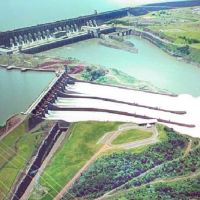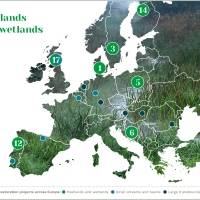An Emergency Recovery Plan for global freshwater biodiversity

2020 could be a pivotal year for the future of Earth’s biodiversity. In November, the world’s governments will meet at the Convention on Biological Diversity (CBD) conference to agree a new global deal to conserve and restore biodiversity.
Global freshwater biodiversity is in particular need of stronger and more effective policy and conservation action. Despite covering less than 1% of the Earth’s surface, freshwater ecosystems support around 10% of all known species, including one-third of all vertebrate species.
However, freshwater biodiversity has collapsed in recent decades. Freshwater species populations have declined by 83% globally since 1970, according to the 2018 WWF Living Planet Report, and now 27% of the freshwater species assessed for the IUCN Red List are threatened with extinction. It is estimated that freshwater habitats host more species per square kilometre than their land or oceans counterparts: yet freshwaters are suffering biodiversity declines two-to-three times faster.
WWF estimates that around 30% of global freshwater ecosystems have been lost since 1970. It’s not just plants and animals that rely on freshwaters – they’re vital for humans too, variously providing water, food, livelihoods, and flood and drought protection.

A major new scientific paper published in BioScience last week outlines an Emergency Recovery Plan for freshwater biodiversity declines, designed to influence discussions at the CBD conference in November. Developed through collaborations between scientists from WWF, International Union for Conservation of Nature (IUCN), Conservation International, Cardiff University and other institutions, the paper outlines a six-point plan to ‘bend the curve’ of global freshwater declines.
Based on contemporary scientific research and conservation strategies, the six key themes of the paper emphasise solutions for positive environmental change. They provide explicit recommendations for improving freshwater conservation and restoration in international agreements, particularly the CBD and the UN Sustainable Development Goals.
“Nowhere is the biodiversity crisis more acute than in the world’s rivers, lakes and wetlands – with over a quarter of freshwater species now heading for extinction. The Emergency Recovery Plan can halt this decades-long decline and restore life to our dying freshwater ecosystems, which underpin all of our societies and economies,” said Dave Tickner, WWF-UK Chief Freshwater Advisor and lead author on the paper.

The six themes of the Emergency Recovery Plan are: letting rivers flow more naturally, reducing pollution, protecting critical wetland habitats, ending overfishing and unsustainable sand mining in rivers and lakes, controlling invasive species, and safeguarding and restoring river connectivity through better planning of dams and hydropower.
“The causes of the global collapse in freshwater biodiversity are no secret, yet the world has consistently failed to act, turning a blind eye to the worsening crisis even though healthy freshwater ecosystems are central to our survival. The Emergency Recovery Plan provides an ambitious roadmap to safeguarding freshwater biodiversity – and all the benefits it provides to people across the world,” said co-author, Professor Steven Cooke of Carleton University in Canada.
The Emergency Recovery Plan aims to influence global environmental policy in three ways. First, it recommends maintaining existing elements of agreements that are already aligned to the Recovery Plan, such as CBD Aichi target 9 on invasive species and SDG 6 on clean water and sanitation.
Second, it recommends amending or extending existing targets or indicators so that they better align with the Recovery Plan. For example, CBD Aichi target 11 and SDG 15.1 both aim to increase the extent of conserved and restored habitat, but the geographic scale of their designations don’t always suit the wide range of freshwater habitats – from vast river catchments to tiny ponds. Improving these designations could help improve how freshwaters are managed and protected by global policy.
Third, the Recovery Plan identifies major gaps in policies where key freshwater issues are overlooked or underrepresented. For example, there is currently no recognition of alterations to water flows and levels in the CBD Aichi targets.

Cutting-edge freshwater research is increasingly untangling the multiple pressures that affect the health of aquatic ecosystems, and it is vital that this knowledge is translated into policy. To achieve this globally, the authors highlight the need for better collaborations between policy makers, governments, NGOs, researchers, managers and wider stakeholders, all driven by the common desire to halt freshwater biodiversity declines.
“It would be easy to interpret this work as a further message of freshwater doom but it is in fact the opposite. It is a forward-looking plan, with specific areas of action, for how to address the 21st century challenges that our freshwater ecosystems face. It presents an opportunity for us to change the trajectory of biodiversity decline in turn supporting the health of the planet and the livelihoods of people,” said co-author, Ian Harrison, from the Moore Center for Science.
“We have the last opportunity to create a world with rivers and lakes that once again teem with wildlife, and with wetlands that are healthy enough to sustain our communities and cities, but only if we stop treating them like sewers and wastelands,” said Tickner. “This decade will be critical for freshwater biodiversity: countries must seize the chance to keep our life support systems running by ensuring freshwater conservation and restoration are central to a New Deal for Nature and People.”
+++
David Tickner, Jeffrey J Opperman, Robin Abell, Mike Acreman, Angela H Arthington, Stuart E Bunn, Steven J Cooke, James Dalton, Will Darwall, Gavin Edwards, Ian Harrison, Kathy Hughes, Tim Jones, David Leclère, Abigail J Lynch, Philip Leonard, Michael E McClain, Dean Muruven, Julian D Olden, Steve J Ormerod, James Robinson, Rebecca E Tharme, Michele Thieme, Klement Tockner, Mark Wright, Lucy Young, (2020) “Bending the Curve of Global Freshwater Biodiversity Loss: An Emergency Recovery Plan”, BioScience, https://doi.org/10.1093/biosci/biaa002















Comments are closed.